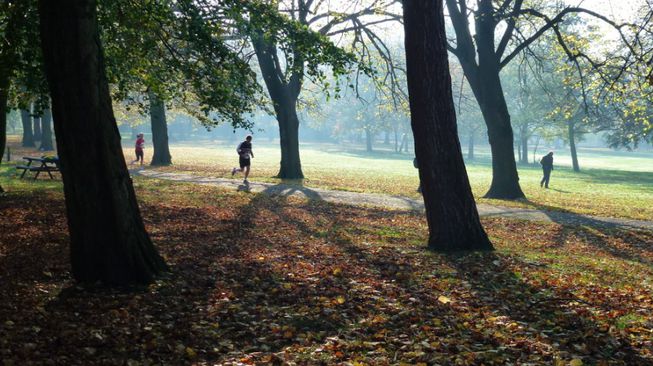Source: mnn.com
Published: January 25, 2017

Alexandra Park, a large urban park in Manchester, England, is getting some leafy company thanks to the City of Trees initiative, which will oversee the planting of 3 million new trees while caring for and reviving existing woodlands. (Photo: Alex Pepperhill/flickr)
By Matt Hickman
Throughout its long history, the word “green” hasn’t generally been used to describe the northern English city of Manchester. After all, Manchester — the original “Cottonopolis” — served as the soot-smeared heart of England’s Industrial Revolution with its seemingly endless sprawl of textile mills and factories. Described by historian Simon Schama as “a new kind of city in the world; the chimneys of industrial suburbs greeting you with columns of smoke,” if there was a color to best describe the world’s first industrialized city during the 19th and early 20th centuries, it would be a dull brownish-grey.
Manchester, of course, has evolved radically over the years. A major tourism destination, an epicenter of science and innovation and a cultural hub best known for its nightlife, architecture, performing arts scene and massively influential musical exports (the Smiths, Oasis, New Order, et al.), Manchester has shed its dreary, filth-encrusted Dickensian reputation and emerged as a world-class city that anchors England’s second-most populous urban area. And, yes, today’s Manchester is green — and it’s about to get impressively greener.
Under an ambitious new urban beautification scheme titled City of Trees, Manchester will be home to a total of 3 million new leafy specimens to be planted over the next 25 years.
So why 3 million?
The figure numerically represents the current population of the Greater Manchester metropolitan area (the city proper is home to just over a half-million residents). As such, a tree will be planted for each and every Mancunian — every man, woman and child hailing from Blackrod to Broadbottom and everywhere in between — while an additional 2,000 hectares of neglected and overlooked existing woodland will be revived.
To date, 94,380 trees — this figure includes 318 street trees and 846 fruit-bearing trees — have been planted as part of the “innovative and exciting movement” that’s “set to reinvigorate Greater Manchester’s landscape.” In the process, 7,000 Mancunians who may have felt a disconnect from the natural world are now, according to the initiative, “connected to nature.”
As City of Trees director Tony Hothersall explains to the BBC, the objective of the project extends well beyond the planting of 3 million trees across Greater Manchester:
Next, we are very much focused on bringing existing woodland into management because there is no point in planting new woodland if you can’t manage what you’ve got already.
Finally, we want to engage people a lot more in their natural environment; in planting trees; in managing areas; in understanding more about the benefits that trees and woodlands bring to our society.
Greater Manchester wants to be a world-class city region. We have a lot of fantastic built development going on, but the natural environment needs to keep up with that.
The arboreal benefits mentioned by Hothersall are vast. As Mother Nature’s most remarkable multi-taskers, urban trees scrub dirty air, sequester carbon and reduce the severity of flooding events all the while fostering the growth of biodiversity. The positive — even life-saving — impact that trees have on the mental and physical wellbeing of a city’s denizens cannot be ignored.
And then there’s the matter of our gradually warming planet. City of Trees sees the project as a first-line defense against the impacts of climate change, particularly when it comes to the natural shading and cooling abilities of trees. Not only are cooler cities more comfortable but they’re also ultimate cleaner as trees help to lower a city dweller’s reliance on energy-intensive air conditioning, which, of course, requires the burning of fossil fuels – an activity that Manchester is historically very well acquainted with.
Speaking to the BBC, Hothersall goes on to elaborate that City of Trees, an initiative spearheaded by the Oglesby Charitable Trust in partnership with the Community Forest Trust, is working with an array of partners to “identify parcels of land for tree planting.”
“It is really about planting trees wherever it’s appropriate to put trees,” Hothersall says. “What is really important is it’s about the right tree in the right place.”
Click here to watch “Introducing City Forest Park”: https://youtu.be/BouN0gVkJRk
And speaking of “right places,” Hothesall mentions specific examples demonstrating that urban trees can be good for the bottom line. Restaurant- and shop-flanked pedestrian zones that are also lined with trees tend to perform better than similarly retail-heavy areas where trees are scarce. Essentially, trees make people want to linger for longer amounts of time — and spend money.
Leafy retail havens aside, one of City of Trees’ larger individual projects is the creation of City Forest Park, an expansive urban green space (“the green beating heart of Greater Manchester”) proposed for once-forsaken industrial land that, at 800 acres, would be larger than London’s Hyde Park and Regents Park combined and larger than Central Park in New York City. Hothersall notes to the Manchester Evening News that “with the right investment, we will be able to realise City Forest Park’s full potential and give the region the inspiring green space and culture hub it deserves and needs.”
